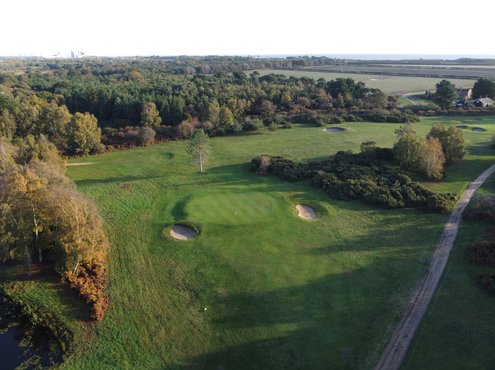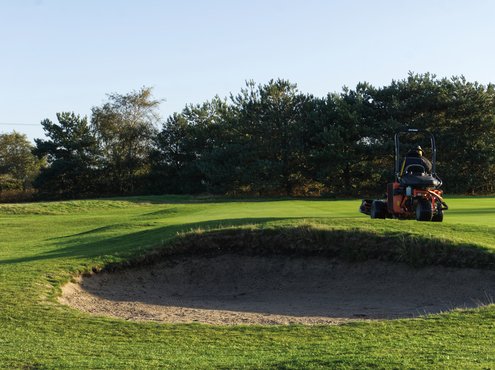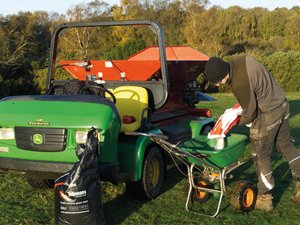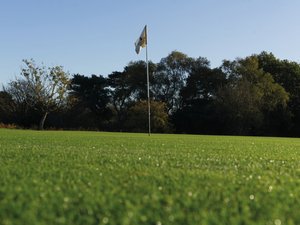Thorpeness Golf Club - A strange time!
Since March 2020, the phrase 'a strange time' has been used constantly to describe the world we are all currently living in. However, for Thorpeness Golf Club and Hotel's new Course Manager, Wallace Wilson, those three words could not ring more true.

Wallace Wilson's position before Thorpeness was at Milngavie Golf Club where he was only the third Head Greenkeeper in their history. As a rule, those who had the job stayed for life but, after eighteen years, the time was right for Wallace to seek a new challenge, something that is a theme throughout his career.
At twenty-one years old, on the advice of his boss at Clydebank & District Golf Club - Wallace's local club where he was born in the hospital that used to overlook the 18th fairway - he moved to Royal Ashdown Forest as one of two Head Greenkeepers, serving under a Course Manager, before seeking grow-in and construction experience at the nearby Sweetwoods Park Golf Club.
After nine years and with his parents and children getting older, he decided to head home to Scotland and Milngavie was his destination. Project-based jobs have been a characteristic of Wallace's course choices, be it learning, gaining grow-in and construction experience or undoing the issues caused by the enthusiasm of Grow a Tree in '73 and plant some more in '74 at Milngavie.
The experienced Scotsman arrived on the Suffolk Coast on 3rd February 2020 to begin work on his latest project, with heather regeneration at the forefront. What should have been a time of getting to know the course and staff was stopped in an instant, and Wallace was faced with a situation unlike anything he'd experienced in his thirty-six-year career
"I remember the day when we closed, it was just me here, and that was a pretty surreal kind of time going around and taking all the flags out and thinking this is us closing our doors, what's next? Literally, what is next? Are we ever going to open again?" Wallace explains.


"Obviously, all these things are going through your head. Am I going to have a job? I've only been here a few weeks. I could have been in my previous job for the rest of my life if I wanted, like the guys before me. That never really crossed my mind in terms of have I done the right thing, that didn't really come into it because you make decisions based on what is in front of you at the time, and that was what I felt was the right decision. I didn't really beat myself up or anything like that, but it did cross my mind. But obviously, you do think what does the future hold, as everyone was and maybe still is. Being in a new job, you're also thinking it's a lot easier to get rid of someone that's only been there a few weeks, no matter how well they might think of you, which they do, and I appreciate that. The club and the company backed me really well during that time and were in constant dialogue, and they showed appreciation for what I was doing when it was me on my own."
"So it was never a worry as such, but there was a general worry for everyone. But, as I said, it was strange for everyone. My house is down at the bottom of the practice ground, and you're looking out thinking what's going on. You can see the 'House in the Clouds' and eighteenth hole from the house, and you look out and see loads of dog walkers and people having picnics. Every day I'd go around and make sure everything was okay for my walk, and there would be four or five picnics and days out going on and kids playing in bunkers and things like that, it was an absolute bizarre time. We actually had a picnic going on in front of one of the greens when we'd only been open for two days, and they were still doing it even though golfers were out playing."


"I started working on 3rd February, and we were working on things, machinery deals and projects were moving forward, but it all died within five weeks of being here."
"The only people I knew were the guys here, and I hadn't had a chance to meet anyone. I actually picked up my dog, Arnie, just before lockdown, so it was him and me from then on. Everyone was furloughed straight away. It was a really difficult period, and we managed to get people back gradually as lockdown progressed, but it was really tough to try and keep the place viable over those few weeks."
With all the team furloughed, Thorpeness essentially lost an entire spring. Dry weather helped by slowing the growth of grass but, as a consequence, wetting agent and other programmes fell behind. Despite the course reopening on 13th May, the greenkeeping team wasn't back to its full complement of eight until towards the end of July.
This meant a massive effort from the guys on the course to get it to as good as it could be, but circumstances were made more difficult with failing machinery that itself almost brought work to a halt.
"Initially, there were only two of us back, so me and one other for two or three weeks, and then we gradually got back to our full staff of eight. The guys who were here have obviously done amazing work, and we were back to as good as we could expect to be by mid-June, after opening on May 13th, so around a month from then. At that point, we had four back full-time, so things were getting easier; we were still in the process of getting our machinery package back on the go. We had some old bits of kit that wasn't exactly doing us any favours, but Ernest Doe are great, and they lent us quite a few bits and pieces, and that helped us out a lot."

"We had kit which was broken down that we couldn't get away to get fixed at that point. So it was a case of, at one stage, we were down to one machine for a little while. Nothing could get fixed, and other kit was unreliable, and it felt like there was no way out of it. We had a moment of that, and when I was speaking to the management at that point, I was explaining we were literally one machine away from us being able to do nothing. That's how close to the wind we were from being totally redundant in that sense."
"We would have been doing stuff by hand, and that would have been it. We never quite got there thankfully and, again, Ernest Doe stepped in and gave us a couple of machines, but in terms of taking stuff away and getting it serviced, it was never going to happen during that period. To be on a much better footing in that way inspires confidence because, if the worst came to the worst and there was another lockdown, at least we've got what we need. We've also been in discussions, and we've been making sure we have materials in for projects through the winter now, so we don't have to buy anymore, and we've got everything we need and I guess everybody has been doing things like that. That's a comfort for me because it's good to know we're not going to be in a bad situation with machinery or materials, if we were to be locked down again."
Like a lot of courses, Thorpeness hosted their fair share of golf during the first lockdown. In July, they had record-breaking green fees by the 21st of the month which, whilst fantastic for the club and those who were able to spend some much needed time outside, meant almost no time for Wallace and his team to carry out necessary maintenance. This was to the point that there were genuine celebrations when a forty-minute gap appeared one afternoon in early October for work to be done - the first gap since mid-May.


Now the catching up is done, Wallace's attention has turned back to improvements and long-term projects. The addition of a new Jacobsen fleet of mowers, Wiedenmann aeration machinery, and heather management equipment to come, have set a solid foundation to build on from where they left off in March. Simply by listening to Wallace talk, you can tell his passion for the project and eagerness to make progress. Even before his interview, he walked the course to see where he could make an immediate impact and how he would implement the club's landscape management plan. From those early stages, he started to shape a vision for the course and now, after a longer than expected time, he's finally getting to start his latest project.
Wallace explains: "I had a meeting with all the boys, individually and collectively, when I came here and said I'd have a little bit of a watching brief to see how they work because they were doing a good job. I was taking notes in terms of a long-term project that I already had in my mind but, to be honest, it never really lasted that long, it lasted about a day!"
"We needed to change a few things straightaway, not in a derogatory way to them at all, but things didn't fit into how I saw the vision of what we were doing. From there, everything started to change, and we quickly went back to square one and back to basics. We were trying to get ourselves open and playable again. Almost, I guess, like my days at Sweetwoods Park which I suppose unconsciously sort of helped, from taking somewhere from nothing coming back to being playable. Obviously, it was different, but there were still a lot of the elements that were sort of the same within that. And really, they were quite exciting days opening up again and putting the course furniture out because it had been so long."


"Most of the landscape management plan the club sent me is based on the heather regeneration side, so there wasn't much in there on the actual golf course side. That has been left to me. What I gathered from the early days, and what I could see straight away, is that there's a lot less fescues out there than there should be. It's essentially a links golf course, primarily because it's heathy and linksy and because this side of the golf course is almost in the sea and its pure sand. It gets a bit different on the back nine of the course, that's where there's more heather."
"The heather management is huge and, if we get the equipment for that, it's going to push on really quite quickly and we'll see a big difference. We won't see a lot this winter because we did a lot of pure clearance and we'll do some more of that this year again, but heather takes a long time to get going. You've got to create the exact environment for it, otherwise it just won't work. It is a big interest of mine, and I've done a lot of projects like it before, and the one at Royal Ashdown, in particular, was very successful. It's something that really interests me, getting places back to heathland. I guess this isn't a unique mix, but having more linksy characteristics one side of the road and more true heathland on the other side, with a bit of a mix in places, is almost like having two different golf courses."
"Two completely different areas, but both uniquely exciting and aesthetically nice. You've got the House in the Clouds on this side whilst, on the other side, you'd think you were in the middle of nowhere. So our main focus is to try and tip the balance towards fescue domination in fairways and rough, and that's a big long-term change. It is playable three-hundred and sixty-five days a year, but it needs to be more than playable; we want people to enjoy the experience and, in the last couple of winters, that has been happening. I wouldn't have been happy to present it like it was, so that's our long-term goal."



"What's happened over the years is there's been ingress of ryegrass. There's been overseeding, I suspect, of ryegrass, which has diluted a lot of the characteristics of what should have been here, and what I think should be here now, which is more fescue dominated. The place droughts very quickly and the only thing that will survive that is decent fescue. So, we've been overseeding, but we'll probably stop now because it's getting a bit too late, but we'll be looking at that again in the spring. There's going to be a lot of overseeding in terms of trying to get more fescues back in, particularly to fairways, the greens are bent fescue mixed and are probably going to stay in that vein; we aren't going to try and change them too much because they're decent."
"Aeration has been lacking quite seriously in the greens, so again that's something I started looking at straight away. But again that's really from pressures of trying to get as many rounds of golf as we can and not upsetting anybody by doing aeration work. But the club is on board with it, and we need to do it, and it got to a stage last year where the greens were on the edge. When I saw them during my interview, to me it was a bit of a wow moment and something I thought we needed to change really quickly. Again, everyone is on board with that and the two new Wiedenmann machines we've got will help us there."



"There will be a lot more of that, which will help create the right environment for the fescues and bents, which we want to encourage more of. That's going to be a bit more of a long-term project, and it depends on how much we spend on overseeding as well. That's all to try and get back to what it should have been and would have been before I started. It's heavily played, so we've got to factor that in as well, it's got to be wear tolerant, but it's a great golf course, and it deserves to be put back to what it was in that term."
"I think there is so much here that can evolve and so much that can change. There's a lot of good here, a real lot of good, and the potential is huge. You'll always be limited with potential wherever you go, but the potential here is pretty big. Obviously, they got into the Top 100 in 2018, and there's a ceiling there you can get to anyway because there are venues that you're never going to get above, but we've got so much scope."
"If we get the right backing, and if the team stays together and we keep going the way we've gone, then it should be quite stratospheric the difference we can make. It's exciting to think of that, and I think that can last five years easily. I think it can last quite a lot more than that, if I'm being honest. I think there are five years of huge improvement and probably another five years of pretty big improvement at least, so I think I'll have plenty of time here."

The House in the Clouds
The House in the Clouds is a water tower at Thorpeness, Suffolk. It was built in 1923 to receive water pumped from Thorpeness Windmill and was designed to improve the looks of the water tower, disguising its tank with the appearance of a weatherboarded building more in keeping with Thorpeness's mock-Tudor and Jacobean style, except seeming to float above the trees.
The original capacity of the water tank was 50,000 imperial gallons (230,000 litres) but, during the Second World War, the House in the Clouds was hit by gunfire from anti-aircraft guns based at Thorpeness. The water tank was repaired using its own steel, which resulted in a reduced capacity of 30,000 imperial gallons (140,000 litres).

It has been a Grade II Listed Building since 1995.
